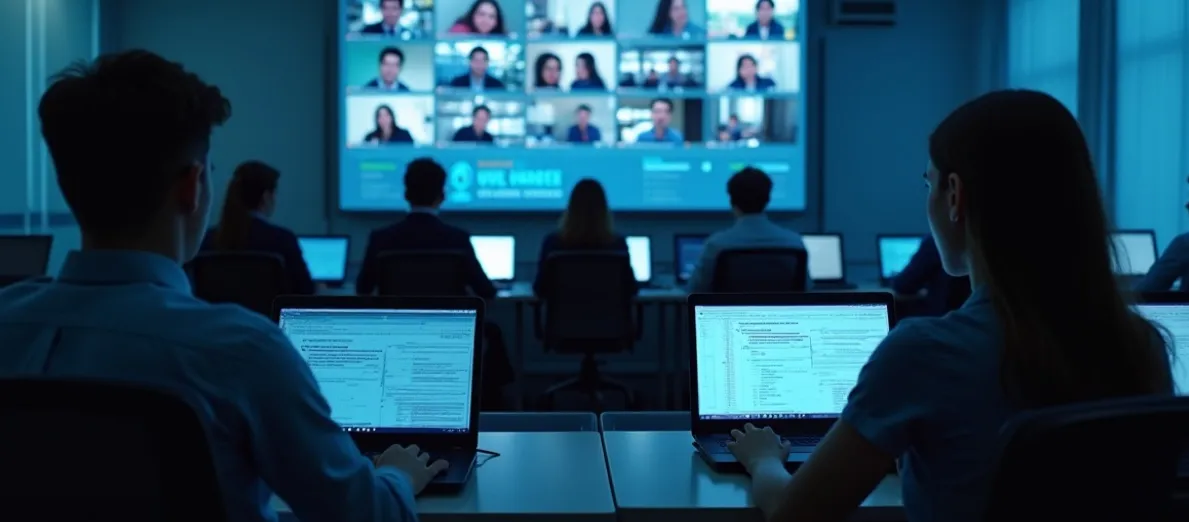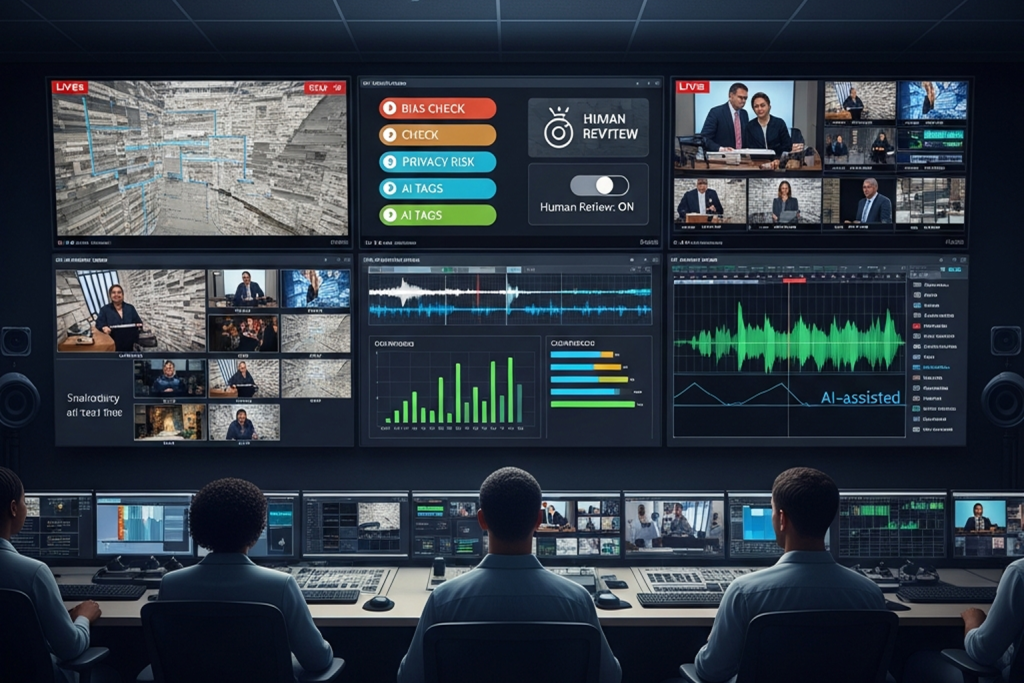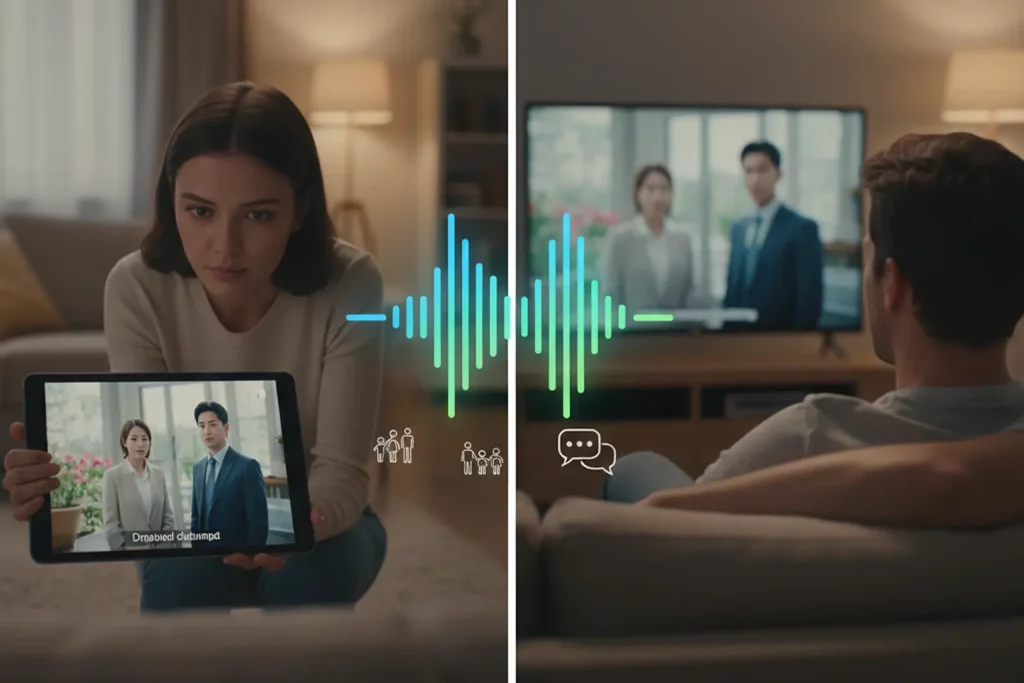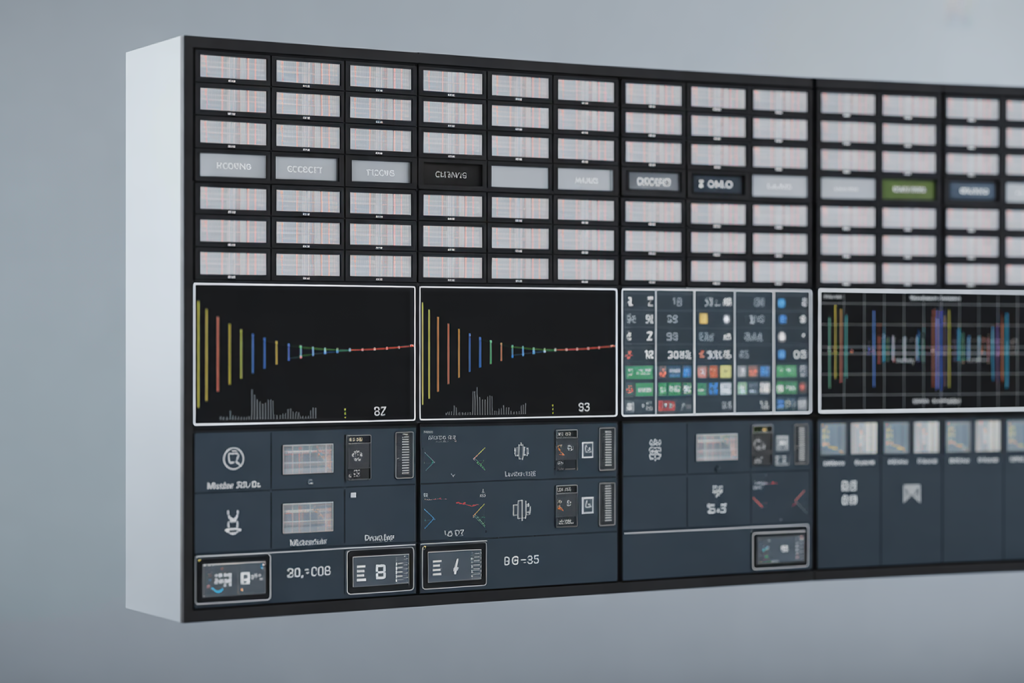Online exam proctoring services help colleges, universities, and certification bodies run secure digital tests without the need for physical testing centers. A proctored exam online can be monitored live by human proctors, recorded for later review, or checked automatically through AI-based proctoring tools. Remote proctoring ensures exam integrity by confirming student identity, watching for suspicious behavior, and preventing impersonation. Secure online test proctoring gives institutions confidence that exam results reflect genuine knowledge while giving students the convenience of testing from anywhere. The proctoring process includes registration, ID verification, lockdown settings, and exam scheduling to create a complete exam experience that feels clear and fair.
Why successful online proctoring requires more than software
Successful online exam proctoring services demand more than a plug-and-play software. Institutions must consider both technology and human oversight to maintain exam integrity. Proctoring solutions involve AI-based monitoring, live human proctors, and policies for handling suspicious incidents. Exam integrity depends on strong collaboration between software that flags issues and human judgment that validates those findings. Relying solely on automation risks false positives, while relying only on human monitoring can stretch resources. The right balance of tools and people ensures a secure and fair testing environment.
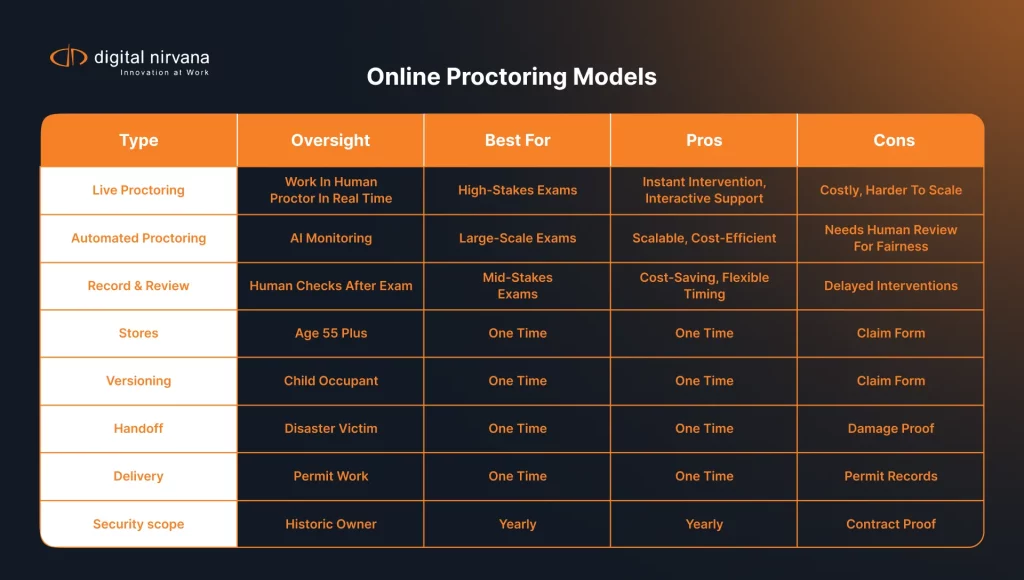
Balancing proctoring software with human proctors for exam integrity
Proctoring software detects browser activity, unusual eye movement, and secondary device usage, but human proctors interpret context. For example, a student glancing away could be distracted by noise rather than cheating. Human proctors provide judgment in cases where AI might overreact. Institutions that combine AI and human oversight preserve credibility while also scaling exams efficiently. This hybrid model prevents overreliance on either side and delivers confidence to both faculty and students.
How Digital Nirvana’s remote proctoring blends technology and human oversight
At Digital Nirvana, remote proctoring services blend AI-driven detection with live human review to ensure exam integrity. Our proctoring tools record sessions, monitor student activity, and flag irregular behavior. Human proctors then verify and act on these flags, avoiding unnecessary stress for students caused by false positives. This dual-layer approach creates a secure environment where institutions trust exam results and students feel treated fairly. By integrating with LMS and exam workflows, Digital Nirvana ensures smooth operations and scalable solutions for secure online exams. Explore our Education Assessment and Proctoring services to see how identity checks and incident workflows fit your testing policies.
What remote proctoring means and how it works
Remote proctoring allows students to take exams from any location while being monitored through secure online proctoring software. Institutions can choose between live monitoring, automated detection, or record-and-review options. The remote proctor confirms identity before the exam starts, supervises test behavior, and ensures no outside help occurs. Proctoring solutions rely on webcams, microphones, screen monitoring, and AI analysis to maintain exam integrity. This method reduces the need for physical testing centers while preserving fairness. Students can register, receive proctor requests, and use desktops or laptops with webcams to complete their exams. For a simple primer, see our blog on Understanding Online Proctoring.
What is remote proctoring and what does remote proctoring mean
Remote proctoring refers to supervising exams digitally instead of at a physical test center. A remote proctor monitors test-takers through their devices, ensuring compliance with exam rules. The process may include recording sessions, real-time monitoring, and AI-based alerts for suspicious activity. Students benefit from convenience, while institutions maintain control over exam integrity without logistical burdens.
What role does a remote proctor play in validating identity
A remote proctor confirms student identity through photo ID checks, facial recognition, and sometimes biometric authentication. Before an exam starts, students show valid ID to the proctoring service. Some systems use AI to compare live images with ID photos. This step prevents impersonation and protects the credibility of proctored exams. Human proctors validate final checks, ensuring fairness and accuracy.
Our services at Digital Nirvana for secure online testing
Our services at Digital Nirvana support secure online test proctoring from planning to rollout. If you need an assessment partner, our Education Assessment and Proctoring team designs policies, identity checks, and incident workflows that fit your programs. We connect with your LMS through Learning Management Solutions so faculty launch online exams without extra steps. For accessibility and language support, TranceIQ for transcription and captioning helps you meet caption requirements and support diverse learners. When content needs rich metadata for audits or analytics, MetadataIQ adds searchable context that speeds reviews and postexam reporting.
Types of online proctoring services institutions trust
Institutions have several options for online proctoring services, each suited to different needs. Live proctoring, automated proctoring, and record-and-review offer varied levels of oversight and scalability. The choice depends on exam stakes, available resources, and institution policies.
Live proctoring with real-time human oversight
Live proctoring connects students with human proctors who watch exams in real time. This method most closely mirrors traditional test centers by allowing instant intervention if misconduct occurs. Students interact with live proctors through chat or voice to resolve technical issues. Institutions prefer this method for high-stakes exams where exam integrity is paramount.
Automated proctoring with AI-based tools
Automated proctoring relies on AI-based proctoring software to monitor student behavior. These proctoring tools track webcam feeds, detect unusual activity, and lock down browsers to block unauthorized websites. Automated proctoring offers scalability for institutions running thousands of online exams simultaneously. While efficient, it still benefits from human review of flagged incidents to prevent unfair judgments.
Record and review proctoring with human audit
Record-and-review proctoring records the entire exam session for later human review. Human proctors check the footage for suspicious activity after the exam concludes. This method saves costs compared with live proctoring while still ensuring accountability. Institutions often use it for mid-level exams that require integrity but may not justify real-time monitoring.
AI-based proctoring and secure online test delivery
AI-based proctoring tools play a major role in securing online exams. These systems monitor eye movements, background noise, keystrokes, and unauthorized applications. Automated proctoring ensures exams remain fair, even without a human proctor present throughout the test. For decision-makers comparing platforms and learning models, our article on LMS vs. Traditional Learning Methods explains how LMS workflows support secure delivery and consistent grading.
How automated proctoring uses AI to secure exams
AI-based proctoring software applies algorithms to detect cheating attempts such as multiple faces on screen or switching windows. The system immediately flags these behaviors, allowing human proctors to review. Institutions gain scalability, running thousands of online proctored exams simultaneously without losing control. By combining AI with human review, exam integrity stays strong.
Addressing fairness, privacy, and false flags
Students often worry about false flags, data privacy, and fairness in automated proctoring. Institutions must set clear policies to handle these concerns. Human review of AI flags reduces unfair outcomes. Data security practices protect student information under strict compliance standards. Balancing fairness with security builds trust among students and institutions.
How remote proctoring confirms test-taker identity
Identity validation forms the foundation of exam integrity. Proctoring services confirm that the student who enrolled in the course is the one taking the exam. Multiple layers of authentication prevent impersonation and cheating.
Verifying identity with webcam, ID, and biometric checks
Remote proctoring solutions verify student identity through ID scans, facial recognition, and biometric data. Students show ID to their webcam, and the software checks details against enrollment records. Facial recognition tools ensure the same person remains present throughout the exam. Biometric checks add another level of security for institutions that require higher assurance.
Preventing impersonation in online proctored exams
Proctoring tools prevent impersonation by requiring live ID verification and continuous facial monitoring. Systems detect if another person appears on screen. Browser lockdown features also stop outside help from digital collaboration tools. These layered safeguards give institutions confidence in exam results.
Benefits of proctoring solutions for institutions and learners
Secure online exam proctoring benefits both schools and students. Institutions maintain exam integrity, while students enjoy flexibility without traveling to testing centers. Proctoring solutions also reduce operational costs and scale exams efficiently.
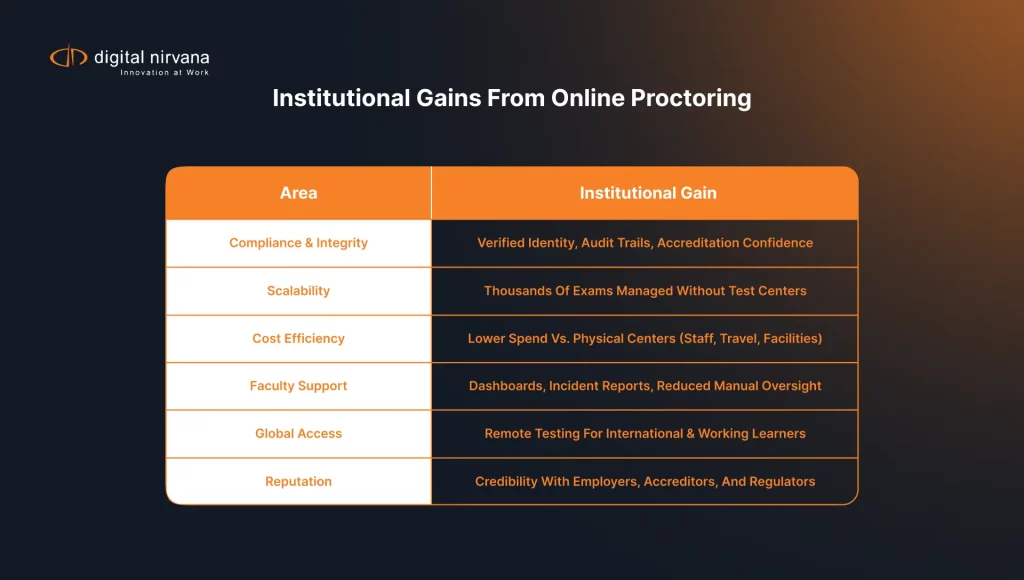
Ensuring exam integrity and credibility in online courses
Institutions offering online courses must prove the credibility of their exams. Proctored exams confirm that students completed the test under monitored conditions. Employers, accreditation bodies, and faculty trust these results, strengthening the reputation of online courses.
Flexibility for students without test centers
Students benefit from remote proctoring by avoiding travel to testing centers. Proctoring services allow them to complete exams from home with the same level of security. This convenience supports diverse learners, including working professionals and international students.
Reducing logistical costs of physical testing centers
Institutions save money by reducing reliance on physical test centers. Online proctoring eliminates the need for renting facilities, hiring on-site proctors, and coordinating schedules. Cost savings allow institutions to scale digital testing without heavy overhead. These savings help schools reinvest in technology and improve exam offerings.
Common challenges in secure online proctoring and solutions
Even with benefits, online proctoring faces challenges such as technical issues, student privacy concerns, and support needs. Institutions must address these challenges for smooth exam delivery.
Connectivity issues, browser lock-downs, and user support
Connectivity problems can interrupt exams. Proctoring solutions with robust support teams help students quickly rejoin tests. Browser lockdown tools sometimes conflict with student devices, requiring strong technical guidance. Institutions should provide tutorials and support before exam day to minimize disruptions. Honorlock and other systems offer real-time help desks to assist during critical moments.
Privacy concerns from students and how to address them
Students worry about how proctoring software handles video, audio, and personal data. Institutions should use vendors with strict compliance policies and transparent data retention practices. Explaining data usage builds trust and eases student concerns. Privacy assurances ensure fairness without compromising exam integrity. Clear communication via email or registration portals keeps students informed.
Student perspective: balancing fairness, stress, and convenience
For students, online proctoring brings convenience but also anxiety. They save time and costs by avoiding travel, yet worry about being flagged unfairly by AI. Students want reassurance that systems will treat them fairly, respect their privacy, and not add stress to an already challenging exam. Institutions that listen to student feedback and adjust policies accordingly see stronger acceptance of online exams.
Institutional perspective: scaling exams with credibility
Institutions face the challenge of scaling online exams without losing credibility. Proctoring solutions help maintain exam integrity, but administrators must balance efficiency, fairness, and trust. By offering flexible proctoring options, from live monitoring to record-and-review, institutions tailor solutions to different stakes. Schools that communicate clearly with students build stronger credibility and acceptance of online testing. For leaders comparing learning models, our breakdown of LMS vs. traditional learning clarifies how LMS features support secure exams and analytics.
Technology innovations shaping the future of online proctoring
The future of proctoring services includes smarter AI tools, better data security, and deeper integration with learning platforms. Biometric authentication, emotion recognition, and adaptive monitoring are emerging features. Institutions that adopt innovations early gain efficiency while improving student trust. For a look at how better tagging and discovery improve review speed, read our post on the best media tagger for finding content fast. Technology will continue to evolve, making proctored exams more seamless, secure, and fair for all stakeholders.
Faculty perspective: supporting instructors in digital testing
Faculty members often carry the burden of explaining online proctoring to students and addressing their concerns. Instructors benefit when proctoring services offer easy-to-use dashboards, real-time updates, and clear reporting. With these tools, faculty can focus on teaching rather than troubleshooting. Humanizing the faculty experience ensures adoption across academic departments.
Global perspective: how online proctoring supports diverse learners
Online proctoring helps global learners access exams without borders. International students, working professionals, and military personnel gain opportunities to complete proctored exams remotely. By supporting different time zones and regional requirements, institutions open doors to broader participation and inclusivity.
Accessibility in online proctored exams
Accessibility must remain a priority in online proctoring. Students with disabilities need accommodations such as extended time, alternative input devices, or live human support. Institutions that choose proctoring solutions with strong accessibility compliance show commitment to fairness for all learners. Review the U.S. Department of Justice guidance on ADA testing accommodations for requirements and examples. For accessible media in course content and exams, TranceIQ captioning and subtitling supports clear communication across languages.
Building trust through transparency and communication
Trust grows when institutions clearly communicate how proctoring works. Students value knowing what data is collected, how long it is stored, and how it will be used. Faculty gain confidence when reports are clear and actionable. By being transparent about policies, institutions reduce resistance and create smoother exam experiences.
Emotional impact of online exams on students
Online proctoring changes the emotional landscape of testing. Some students feel relieved at the convenience, while others feel extra stress knowing cameras monitor them. Institutions can reduce stress by offering practice exams, giving clear instructions, and ensuring support stays available during the exam. Recognizing and addressing emotional impact humanizes the testing process and improves outcomes.
Case examples from real institutions
Universities and certification boards have successfully adopted remote proctoring. One U.S. university used live proctoring for graduate entrance exams, cutting costs of physical testing centers while maintaining credibility. Another institution adopted record-and-review methods for midterm exams, freeing resources for final exams that required live oversight. A corporate training program implemented automated proctoring and reduced retest rates through better identity checks. These examples show how flexible offerings meet diverse institutional needs.
Assessment design that fits online proctoring
Strong assessment design makes online proctoring more effective. Instructors rotate question pools, shuffle answers, and set time windows that match the course’s outcomes. Open-book formats with applied questions reward understanding over memorization. Short essay prompts and problem sets reduce the value of outside help. Clear rubrics tell students what good work looks like and lower appeals.
Student exam-day checklist for a smoother exam experience
A predictable routine lowers stress and improves exam integrity. Students confirm registration, check the email with exam scheduling details, and test their webcam and microphone. They stage a clean desk, arrange a valid photo ID, and run the lockdown browser system check on a desktop or laptop. They close messaging apps, notify housemates, and position lighting so their face stays visible. This checklist creates a fair proctoring site and a calmer exam experience.
Proctor training and code of conduct that respect dignity
Proctors set the tone for fairness. Training covers identity verification, bias awareness, privacy boundaries, and de-escalation. A clear code of conduct requires respectful language, consistent enforcement, and short explanations for each intervention. Proctors log actions in the system so instructors can review the proctoring process later. Students see professionalism and respond with trust.
Incident handling and appeals that feel fair
Incidents happen, and students deserve a fair path to resolution. Institutions publish an appeals window, evidence standards, and a step-by-step review flow. Human reviewers look at flags, room scans, and chat logs before deciding. Students can submit context through a simple form and receive a dated decision. Clear timelines reduce anxiety and protect exam integrity.
Data governance, retention, and student privacy in plain English
Students want to know how long recordings stay on file and who can see them. Institutions set retention periods, restrict access by role, and encrypt data in transit and at rest. Policies describe what the system collects, why it collects it, and how students can request deletion within legal limits. For baseline rules in U.S. education, see federal guidance on protecting student privacy while using online services. Teams that document these practices build trust before test day.
ROI and pricing models that actually save money
Leaders care about cost, scale, and savings. Seat-based licenses fit programs with steady testing volume, while per-exam pricing suits seasonal spikes. Bundled offerings that include live proctoring for finals and record-and-review for quizzes can lower total spend. Schools often report savings compared with renting a testing center and staffing on-site sessions. A simple dashboard that tracks costs per proctored exam keeps budgets honest.
Integration playbook for LMS, SSO, and test engines
Smooth integrations reduce friction for everyone. Institutions connect proctoring tools to the LMS for roster sync, to SSO for one-click sign-in, and to test engines for secure delivery. Sandboxed pilots validate roles, permissions, and grade return before full rollout. Faculty receive short videos that show how to launch an online test and review incidents. For teams mapping content flows, our guide on media indexing meaning shows how metadata planning speeds search and review.
Home testing environment and equipment readiness
Environment matters. Students set up in a quiet room with a stable connection and place the webcam at eye level. They keep the desk clear, remove extra monitors, and test the lockdown browser. If bandwidth runs low, they ask others in the home to pause streaming. A posted checklist on the course page turns these tips into habit.
Equity and bandwidth: practical ways to level the field
Not every student has the same setup. Schools lend hotspots and webcams, extend campus lab hours, and open small testing rooms for students who need them. Flexible scheduling windows help caregivers and shift workers. Clear guidance explains what counts as acceptable equipment so no one guesses. Equity steps like these raise completion rates and reduce support tickets.
Orientation and communication templates that set expectations
Good communication lowers support load. Instructors share an orientation module with a five-minute dry run, a practice quiz, and sample room scan. Templates cover email reminders, proctor request confirmations, and day-of messages with links to support. Students know what to expect and where to ask for help. For a deeper explainer, point learners to our Understanding Online Proctoring article so they arrive prepared.
Hybrid testing: mixing test centers with online proctoring
Some programs blend options to match exam stakes. They route high-stakes licensure tests to a testing center while they schedule lower-stakes quizzes online. This hybrid model spreads demand and lowers lines at peak times. Students appreciate choice, and administrators gain flexibility when emergencies or weather disrupt plans.
Corporate and licensure testing use cases beyond higher ed
Companies, unions, and boards rely on secure online test proctoring to certify skills at scale. Sales teams complete product exams after onboarding. Healthcare workers maintain credentials without taking a day off to travel to a test center. Trade associations run quarterly proctored exams with record-and-review to hold costs down. These use cases prove the model works outside the campus.
Ethics in proctoring: where security meets humanity
Security should never erode dignity. Institutions set camera rules that respect private spaces and define dress codes with common sense. Proctors offer short breaks for long exams when policies allow. Systems avoid invasive scans that do not improve integrity. When leaders center humanity, students cooperate and outcomes improve.
FAQs about remote proctoring with Digital Nirvana
What is remote proctoring and what does remote proctoring mean
Remote proctoring means monitoring exams digitally instead of in a physical testing center. It allows institutions to confirm student identity and ensure exam integrity through secure online proctoring software.
How is remote proctoring helpful for institutions and students
Remote proctoring helps institutions run exams at scale while maintaining integrity. Students benefit from flexibility and convenience without traveling to a test center.
How does the remote proctor confirm the test-taker’s identity
Remote proctors confirm identity through ID checks, facial recognition, and biometric authentication. Human proctors validate final results for accuracy.
What devices can students use for online proctored exams
Students typically use desktops or laptops with webcams and stable internet. Some proctoring solutions also support tablets, depending on exam policies.
Does online proctoring protect student data
Yes, reputable proctoring services use strict compliance and encryption to protect student data. Institutions choose vendors that meet regulatory standards for privacy and data protection.
Choosing the right proctoring solution
Choosing the right proctoring service depends on exam stakes, scale, and student needs. Institutions should select a proctoring solution that balances automation with human oversight.
Why institutions trust Digital Nirvana for exam integrity
At Digital Nirvana, institutions trust our proctoring services because of our blend of AI tools and human proctoring. Our solutions safeguard exam integrity and align with accreditation requirements. Institutions that partner with us gain secure, scalable systems that build trust with faculty and students alike.
Proctoring solutions that integrate with LMS and testing workflows
Digital Nirvana’s proctoring solutions integrate seamlessly with learning management systems and existing exam workflows. This ensures smooth student experiences without added complexity. By fitting naturally into institutional systems, our secure online test proctoring delivers reliable outcomes for all types of online exams.
At Digital Nirvana, we help you deliver trusted proctoring
At Digital Nirvana, we help you implement remote proctoring that students accept and faculty trust. Our Education Assessment and Proctoring specialists set up clear policies, ID verification, and appeal flows. We connect your exam engine and gradebook through Learning Management Solutions for a consistent workflow. For inclusive delivery, TranceIQ brings captioning and translations, and MetadataIQ streamlines audit trails across exams and recordings. Talk to our team to align security with student dignity and keep your program credible at scale.
In summary…
Secure online exam proctoring services combine AI tools and human oversight to maintain fairness and exam integrity. Institutions benefit from credibility, reduced costs, and scalability, while students gain flexibility and convenience.
- Online proctoring monitors exams digitally through webcams, microphones, and AI tools
- Live proctoring, automated proctoring, and record-and-review provide flexible options
- Remote proctors confirm identity with ID checks, facial recognition, and biometrics
- AI-based proctoring ensures scalability while human oversight prevents false flags
- Students enjoy convenience and flexibility without needing test centers
- Institutions save on logistics while maintaining exam credibility
- Faculty gain tools that ease exam management and communication
- Accessibility ensures fairness for students with disabilities
- Transparency and communication build trust with learners
- Emotional support reduces test-day stress for students
- Assessment design and checklists raise completion rates
- Clear privacy rules and data retention policies protect students
In conclusion, online exam proctoring services deliver trusted, secure digital testing environments. By blending proctoring software with human oversight, institutions preserve integrity while adapting to the future of online education.

